#Badisches Landesmuseum Karlsruhe
Explore tagged Tumblr posts
Text
Spolia. Vom Gedächtnis der Dinge: Karlsruhe bis 27. 04. 2025
Im Schloss Karlsruhe werden in einer Studioausstellung – WeltKultur / GlobalCulture – Skulpturen von Myriam Schahabian vorgestellt: Unter “spolia” – zu Deutsch Spolien – versteht man Architekturteile, die von Bauten älterer Kulturen stammen und in neuen Bauwerken wiederverwendet wurden. Als Überbleibsel einer ve gangenen Kultur schlagen Spolien Brücken in die Gegenwart. Myriam Schahabian,…
#Badisches Landesmuseum#Dekor#Denkanstöße#Form#Gewalt#Handwerkskunst#Keramik#Krieg#Kunst#Myriam Schahabian#Repression#Schloss Karlsruhe#Skulptur#Spolien
0 notes
Text

Three Art Nouveau glass vases by Émile Gallé from the late 19th and early 20th centuries at the Badisches Landesmuseum in Market Square, Karlsruhe, Germany
38 notes
·
View notes
Text

"La Nature" by Alphonse Mucha (1899-1900).
Badisches Landesmuseum, Karlsruhe, Germany.
77 notes
·
View notes
Text

MWW Artwork of the Day (8/30/23) Early Cycladic II Period (Greece, 2500-2200 BCE) Group of Three Figurines (c. 2000 BCE) Marble sculpture, 19 x 15.4 x 3.7 cm. Badisches Landesmuseum, Karlsruhe
The best-known art of this period are the marble figures usually called "idols" or "figurines", though neither name is exactly accurate: the former term suggests a religious function which is by no means agreed on by experts, and the latter doesn't properly apply to the largest figures, which are nearly life size. These marble figures are seen scattered around the Aegean, suggesting that these figures were popular amongst the people of Crete and mainland Greece. Perhaps the most famous of these figures are musicians: one a harp-player the other a pipe-player. Dating to approximately 2500 BCE, these musicians are sometimes considered "the earliest extant musicians from the Aegean."
138 notes
·
View notes
Text
Karlsruhe
Karlsruhe ist eine Stadt in Baden-Württemberg, in der Nähe von der Grenze mit Frankreich. Es hat etwa dreihunderttausend Einwohner, und ist ein wichtiges Zentrum für Gesetz - das Bundesverfassungsgericht, der Bundesgerichtshof und der Generalbundesanwalt beim Gundesgerichtshof sind alle in Karlsruhe. Es war auch früher die Haupstadt von Baden, ein historisches Gebiet. Karlsruhe hat sieben Universitäten, zum Beispiel das Karlsruher Institut für Technologie, die Staatliche Hochschule für Gestaltung Karlsruhe und die Hochschule für Musik Karlsruhe. Das Karlsruher Schloss ist ein wichtiges und beeindruckendes Gebäude, das auch als das Badische Landesmuseum dient. Karl Drais und Karl Benz sind beide in Karlsruhe geboren.
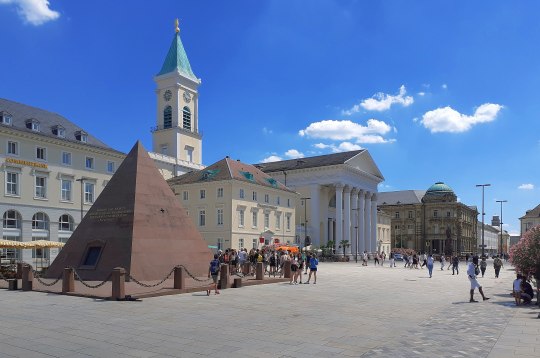
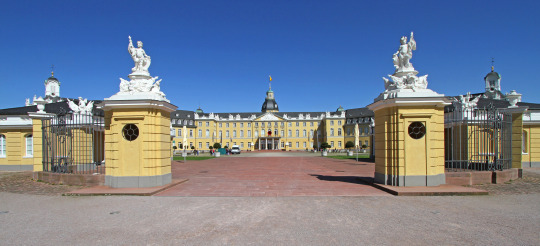

#langblr#learning languages#language learning#learning german#german language#germanblr#karlsruhe#baden-württemberg#baden württemberg#germany#agtew
18 notes
·
View notes
Text
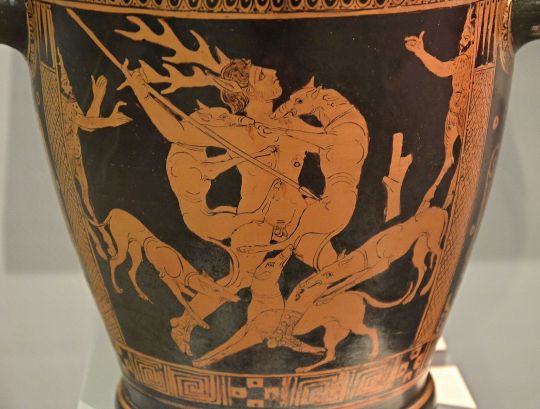

a vase depicting the myth of actaeon from c. 400-350 B.C from the collections of germany's baden state museum // pennsylvania furnace by lingua ignota
17 notes
·
View notes
Text
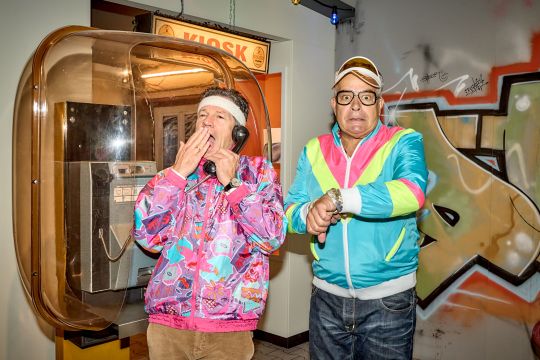
Mit Zeus und Wirby durch die 80er: Comedy-Führung im Badischen Landesmuseum
Am 9. und 10. Dezember werden die Lachmuskeln trainiert. Denn dann kommen die beiden bekannten Radio-Moderatoren Sascha Zeus und Michael Wirbitzky ins Badische Landesmuseum. Auf dem Programm steht eine Comedy-Führung durch die Ausstellung „Die 80er – Sie sind wieder da!“.
Erinnerungen an ein buntes und wildes Jahrzehnt
Die Ausstellung führt durch das wilde Jahrzehnt, das auch beim erfolgreichen Comedy-Duo emotionale Erinnerungen weckt. Damals in ihren Zwanzigern waren sie hautnah dabei und können vieles berichten. Und so schwelgen sie beim Anblick der Kreidler Florett von 1982 auch gleich in Erinnerungen an ihre damaligen Motorräder. Zum Titel der Titanic von 1980 mit dem Bruderkuss von Leonid Breschnew und Erich Honecker mit der Überschrift „Fortpflanzung ohne Frauen!“ stellen sie fest, dass diese Art von Humor heute nicht mehr möglich wäre. Angetan haben es ihnen aber auch die Kleider im letzten Ausstellungsraum. Es handelt sich dabei um typische Mode der 80er. Sie schlüpfen gleich in die bunten Fummel und albern herum. So kennt und liebt man sie.
Interaktive Führung soll Teilnehmer zum Mitmachen anregen
Bei der Führung wollen die beiden aber nicht als Alleinunterhalter performen, sondern das Publikum aktiv mit einbeziehen. Was haben die Teilnehmenden in den 80ern erlebt? Welche lustigen Anekdoten können sie erzählen? Das passt auch zum Gesamtkonzept der Ausstellung, bei der man dem Landesmuseum Gegenstände aus den 80ern einreichen konnte. Diese werden zusammen mit den anderen Exponaten in einem Kiosk gezeigt. Dazu kommen Mitmachstationen wie ein Musikquiz oder Spieleautomaten.
Vielleicht schauen auch Peter Gedöns und Katrin Vierthaler vorbei. Das sind die beiden Comedy-Charaktere von Zeus und Wirby. Peter Gedöns aus Bonn-Poppelsdorf (Michael Wirbitzky) ist allwissend, immer schlecht gelaunt und schimpft gerne auf alles und jeden. Wen oder was aus den 80ern wird er sich wohl verbal vornehmen? Und welche Zusatzinformationen kann er liefern? Katrin Vierthaler (Sascha Zeus) ist eine etwas fülligere, aufgedrehte Bajuwarin, die Probleme mit Fachausdrücken hat. Wird sie etwas zum Rubrik, äh, Rubik Cube sagen, für dessen Lösung selbst der Erfinder einen Monat gebraucht hat? Die Teilnehmenden dürfen gespannt sein.
Für das leibliche Wohl ist auf jeden Fall gesorgt, denn es gibt einen kleinen Umtrunk mit Wein und Häppchen.
Weitere Informationen zu den Comedy-Abenden im Badischen Landesmuseum mit Zeus und Wirby am 9. und 10. Dezember gibt es hier: Comedy-Führung mit Zeus und Wirby (karlsruhe-erleben.de)
Copyright Foto und Text: KTG Karlsruhe Tourismus GmbH
0 notes
Photo
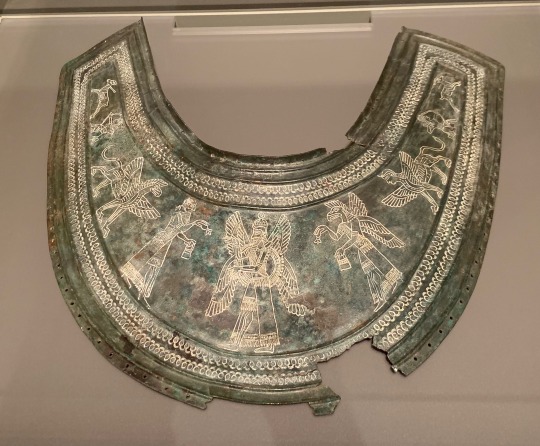
Pectoral from a Horse’s Harness Urartu (Iran, eastern Turkey), 900-800 BCE Karlsruhe, Badisches Landesmuseum 89/8 (on loan to the Louvre’s exhibition Royaumes oubliés, 2019)
#urartu#urartian#assyrian#neo-assyrian#hittite#art history#archaeology#ancient near east#mesopotamia#badisches landesmuseum karlsruhe#louvre#royaumes oublies#ancient art
111 notes
·
View notes
Photo

Stunning Buildings Series: I visited a few places in the last years, just to take stunning pictures as my personal memories. And some of them were also liked a lot by you guys. Thank you so much to all my followers and motivators on my way through photography life. Life wouldn't be the same without you guys. I hope I can count on your support also in 2019. In this sense I wish a happy New Year to everyone.
#Architecture#Badisches Landesmuseum#Castle#City park#Deutschland#Germany#Karlsruhe#Urban Exploration#autumn#autumn colors#city sightseeing#city trip#light#lights#night#night capture#night lights#parc#reflection
1 note
·
View note
Text
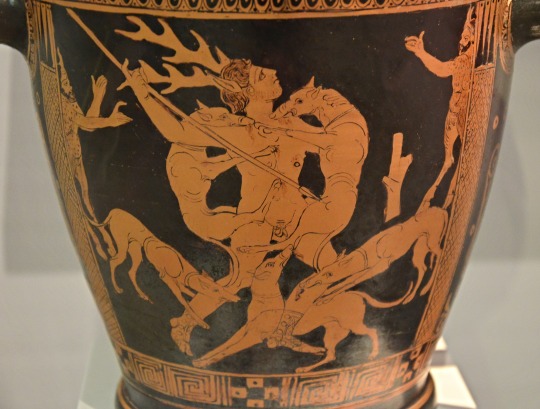
Actaeon, in the process of transforming into a deer, is set upon by his hounds. Apulian red-figure skyphos, artist unknown; ca. 400-350 BCE. Now in the Badisches Landesmuseum Karlsruhe, Germany. Photo credit: Carole Raddato.
#classics#tagamemnon#Ancient Greece#Classical Greece#Magna Graecia#classical mythology#Greek mythology#Actaeon#art#art history#ancient art#Greek art#Ancient Greek art#Classical Greek art#South Italian art#Apulia#Apulian art#vase painting#red-figure#skyphos#Badisches Landesmuseum Karlsruhe
888 notes
·
View notes
Text
Göttinnen des Jugendstils: Karlsruhe vom 18.12.2021 bis 19.6.2022
Göttinnen des Jugendstils: Karlsruhe vom 18.12.2021 bis 19.6.2022
Mystische Frauengestalten, von Fabelwesen bevölkerte Naturlandschaften, florale Ornamente und warme Farbtöne – die Formensprache des Jugendstils lädt ein, für eine Weile in andere Realitäten einzutauchen. In der großen Sonderausstellung Göttinnen des Jugendstils, die in Kooperation mit dem Allard Pierson Amsterdam und dem Braunschweigischen Landesmuseum entsteht, fühlen sich die Besucher*innen in…

View On WordPress
#Alfons Mucha#Allegorien#Badisches Landesmuseum Karlsruhe#Bronzefigur#Femmes fatales#Frauen#Göttinnen des Jugendstils#Goldschmuck#Grafik#Gustav Klimt#Handwerkskunst#Hans Christiansen#internationaler Jugendstil#Jahrhundertwende#Jugend#Jugendstil#Karl Bauer#Keramik#Kunsthandwerk#Naturgöttin#René Lallique#Schmuck
2 notes
·
View notes
Text


Daphne - Stained and painted glass by Hans Gottfried von Stockhausen, 1984, Stuttgart. The background of the piece is filled with handwritten text of Daphne's story from Ovid's Metamorphoses.
Badisches Landesmuseum in Market Square, Karlsruhe, Germany
27 notes
·
View notes
Photo
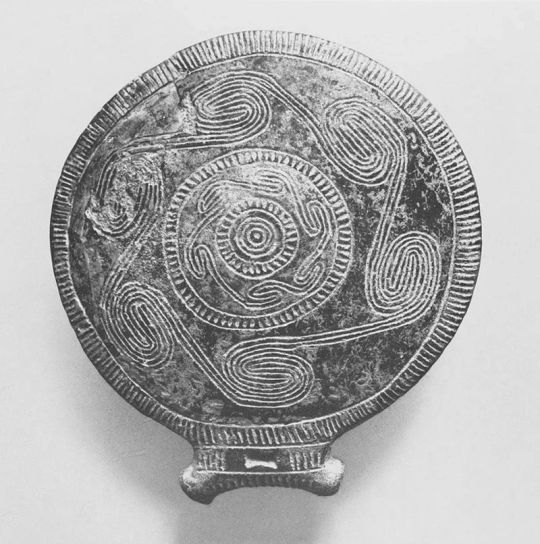
Ckay Vessel, Cyclades. From "Art and culture of the Cyclades in the third millennium B.C." by Badisches Landesmuseum Karlsruhe, 1977. https://www.instagram.com/p/CZPr_OCNncA/?utm_medium=tumblr
77 notes
·
View notes
Text
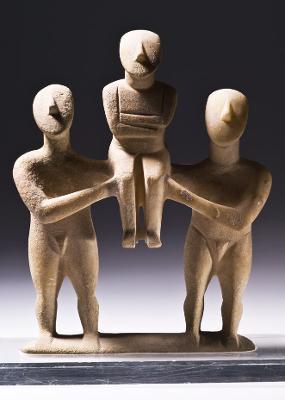
In the group composition, three idols are united in one piece. Two male figures raise a smaller, female figure on their arms. On the forehead of the left of the two men, the rest of a zigzag-shaped line, probably a diadem, can be seen.
This is the only fully preserved Cycladic group composition that is currently known. Their meaning is not immediately apparent; a religious background cannot be ruled out. It remains to be seen whether it is specifically a divine triad or a kind of mythological group or a ritual action carried out as part of a religious festival, which was held here in stone.
Idol Group, Early Cycladic II, around 2700-2400 / 2300 BC, currently held in the Badische Landesmuseum, Karlsruhe, Germany.
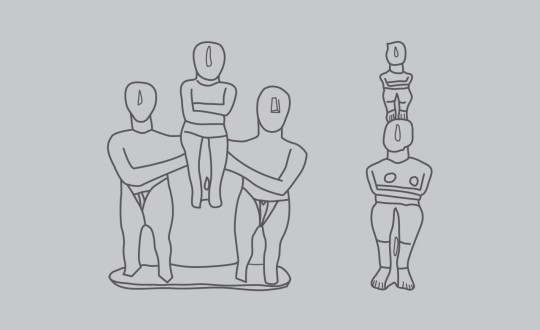
Sketch of the Cycladic Idol Group from the Cycladic Museum, Athens.
Last, there is a small number of unusual examples representing various groups of figures (e.g. “double” figurines with one female standing on top of larger one). Those figurines date to the most productive period of Cycladic sculpture (Early Cycladic II).
The interpretation of the abstract motifs which were painted on the face and body of several figurines is a contested issue. Some scholars believe that they represent instances of body piercing or painted decoration for particular social or ritual occasions. Others believe that they were status symbols. According to another theory, they were meant to express different attributes of the represented figure. It has even been theorized that they functioned as characteristic symbols of a common cultural or social identity. This discrepancy of approaches should not come as a surprise, since the study of painted motifs on Cycladic figurines is still at an early stage.
On the provenance of the Idol Group, from the Badisches Landesmuseum (private correspondence):
The three-figure group Inv. No. 77/59 was acquired by our museum from the antique market in 1977. Unfortunately without indication of the provenance, previous owner or the place where it was found. So far there have been no scientific investigations that could reveal any residues of paint, minerals or sintering. But we will do this in the near future. Then hopefully we can say more about this group.
On the history of Cycladic art and its trade, from Hyperallergic, Sorry, But This Is Not “Repatriation”
Cycladic figurines are marble statuettes produced by the small-scale communities in the Aegean Cycladic islands in the third millennium BCE. A smaller number of them has been found in Crete, and an even smaller amount is still in mainland Greece and in western Anatolia (but in this case they belong to a specific type). They were mostly found in burials, although more recently several have been found in domestic contexts, and in some ritual deposits, most notably on the tiny Cycladic island of Keros, the focus of an ongoing, systematic archaeological investigation and the site of major illicit looting in the past.
Cycladic figurines are often called magical and enigmatic, plaudits that add to their appeal. But they are enigmatic for a reason. Archaeologically, we know very little about their role and meaning because they have been extremely unfortunate to attract, after millennia of neglect, the attention of modernist western artists, mostly in the second half of the 20th century. The likes of Picasso, Giacometti, and Moore were inspired by them and elevated them to the status of masterpieces, admiring in particular their perceived austerity and simplicity. They became part of the culture of “high art” and of the discourse on connoisseurship. Demand from rich collectors and museums rose dramatically, which led to the looting of many hundreds of archaeological sites, destroying for good the archaeological knowledge that comes from context and its detailed and careful study. As a result, the vast majority of Cycladic figurines currently in museums and collections lack provenance and are the outcome of looting. An industry of fakes also rose, and when using marble from the same islands it’s almost impossible to tell apart from the prehistoric originals. Many fakes were bought by major western museums and collectors, corrupting the whole corpus. This is all already well-known, staple diet for any undergraduate archaeological curriculum.
On a current deal to "repatriate" some of these figures from a private collection in the US, via the same article:
This is the line of argument that the current government has also adopted in relation to this deal: they will come back to the country, in 50 years. But at what cost? Whitewashing the looting of archaeological sites? Transferring the possession of antiquities and the income generated from them to private museums that have been either created as a result of looting or are implicated in the handling of looted objects? Privatizing archaeological material heritage in general? Undermining all restitution claims by Greece and others? What about the reparations for the destruction of archaeological knowledge and context, the destruction, in fact, of the Early Cycladic worlds? And how are these objects to be presented and interpreted to the various publics, given the absence of any contextual information?

A commitment to finding out more, among other things.
5 notes
·
View notes
Text
Spritz-Deco
A compressor rumbling. A nozzle hissing. The colorful geometric shapes decorating this otherwise straightforward dish were not painted by hand. Rather they were applied by a device novel to the world of ceramics: the airbrush.
The important and prolific German designer, Martha Katzer (1897–1947), created this dish for the Karlsruhe Majolika Manufaktur (KMM) in Baden, Germany. Katzer arrived at the KMM in 1922, and quickly rose through the ranks. By the end of the decade, she had become a lead designer of KMM’s commercial ceramics.[1] The role came at a difficult moment in Germany. The country was still struggling economically following its disastrous defeat in World War I. Katzer’s designs for KMM, however, were able to find great commercial success because they incorporated new materials and approaches to the serial production of ceramics that made them more affordable and accessible to a broader market.
One example was the use of molded Steingut—an inexpensive porcelain substitute. Another, and more recognizable, was the introduction of Spritzdekor (airbrushing), which KMM began to implement in 1928.[2] The technique allowed for glazes to be applied quickly and evenly, leading to lower manufacturing costs. In addition, by using standardized stencils, color and decoration could be applied with greater ease and less technical training, reducing costs even further. Katzer, who had started as a ceramic painter, took to designing a number of stencils for KMM. Her designs incorporated layered geometric forms and repeating linear patterns. Influenced by the Bauhaus, this geometric aesthetic of German Art Deco had become all the rage by 1930. The combination of the simple geometry and bright, atmospheric airbrushed patterns in pastel colors led KMM to market their products as “Fröhliche Sachlichkeit” (Joyful Objectivity).
Devon Zimmerman is a Fellow in the Product Design and Decorative Arts Department at Cooper Hewitt, Smithsonian Design Museum and a PhD candidate at the University of Maryland, College Park
[1] Eva Sindler, Fröhlich, sachlich, edel: Martha Katzer, Keramik aus der Majolika-Manufaktur Karlsruhe, 1922–1942 (Karlsruhe: Badisches Landesmuseum, 2001), 10–11.
[2] Tilmann Buddensieg, Keramik in der Weimar Republik: 1919–1933 (Nurnberg: Germanisches Nationalmuseum, 1985), 11. The use of airbrushing on ceramics was studied and eventually implemented at the Staatliche keramische Fachschule zu Bunzlau (State Ceramic School in Bunzlau).
from Cooper Hewitt, Smithsonian Design Museum https://ift.tt/36SycEA via IFTTT
3 notes
·
View notes
Text
Wellness Karlsruhe
Der benachbarte Botanische Garten bietet neben einer faszinierenden Pflanzenvielfalt auch ein reizendes Terrassenlokal in einem ehemaligen Gewächshaus. Im Zentrum der Stadt thront die Residenz des Markgrafen Karl Wilhelm. Ganz in der Nähe finden Kunstliebhaber die Staatliche Kunsthalle, Wellness Karlsruhe in der Gemälde und Skulpturen aus sieben Jahrhunderten gezeigt werden. Wenn Sie aufregend sind, um Ihre Zeit zu genießen, dann ist es ein perfekter Ort für Sie. Sauna Karlsruhe ist nach Stuttgart und Mannheim die drittgrößte Stadt in Baden-Württemberg. Es beherbergt das badische Landesmuseum mit seiner sehenswerten Sammlung.

0 notes